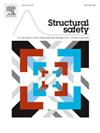The JCSS probabilistic model Code, future developments
IF 6.3
1区 工程技术
Q1 ENGINEERING, CIVIL
引用次数: 0
Abstract
To assess and verify the reliability of structures, reliability based building codes allow for the application of full-probabilistic methods and semi-probabilistic methods (i.e. the partial factor method). In principle, both methods should be equivalent and lead to (approximately) the same reliability level. Therefore partial factors should be as much as possible determined based on a probabilistic background and calibration exercises. On the other hand, as the probabilistic design method may be considered as more rational and consistent than the partial factor design, there is a tendency to use probabilistic methods directly in the assessment of special of important new structures and also in the assessment of existing structures. In both the calibration exercise and in the full probabilistic assessment of structures, we face the problem that many assumptions have to be made. In particular in regard to the statistical modelling of random variables and in regard to accepted approximative methods of calculation. This often brings the engineer to a challenging position. In the past years the JCSS probabilistic model code (PMC) has served as an often-consulted operational code for this purpose. In the present paper, the JCSS PMC and its future developments are presented and discussed.
JCSS概率模型代码,未来发展
为了评估和验证结构的可靠性,基于可靠性的建筑规范允许应用全概率方法和半概率方法(即部分因子方法)。原则上,这两种方法应该是等效的,并且产生(近似)相同的可靠性水平。因此,部分因素应尽可能根据概率背景和校准练习来确定。另一方面,由于概率设计方法比部分因子设计方法更为合理和一致,因此在特殊的重要新结构的评估和既有结构的评估中,有直接使用概率方法的趋势。在校正工作和对结构进行全面概率评估时,我们面临的问题是必须作出许多假设。特别是关于随机变量的统计建模和关于可接受的近似计算方法。这通常会把工程师带到一个具有挑战性的位置。在过去的几年中,JCSS概率模型代码(PMC)一直是为此目的经常参考的操作代码。本文对JCSS PMC及其未来发展进行了介绍和讨论。
本文章由计算机程序翻译,如有差异,请以英文原文为准。
求助全文
约1分钟内获得全文
求助全文
来源期刊

Structural Safety
工程技术-工程:土木
CiteScore
11.30
自引率
8.60%
发文量
67
审稿时长
53 days
期刊介绍:
Structural Safety is an international journal devoted to integrated risk assessment for a wide range of constructed facilities such as buildings, bridges, earth structures, offshore facilities, dams, lifelines and nuclear structural systems. Its purpose is to foster communication about risk and reliability among technical disciplines involved in design and construction, and to enhance the use of risk management in the constructed environment
 求助内容:
求助内容: 应助结果提醒方式:
应助结果提醒方式:


